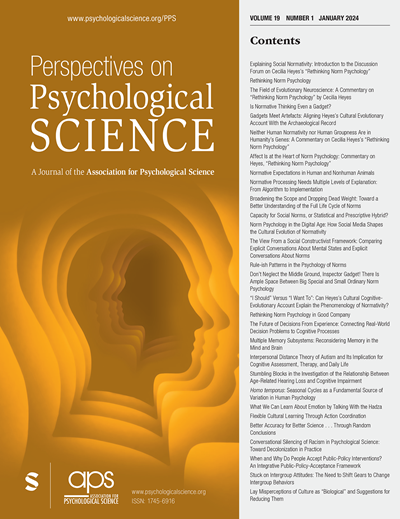The Theory of Constructed Emotion: More Than a Feeling
IF 8.4
1区 心理学
Q1 PSYCHOLOGY, MULTIDISCIPLINARY
引用次数: 0
Abstract
A recently published article by van Heijst et al. attempted to reconcile two research approaches in the science of emotion—basic emotion theory and the theory of constructed emotion—by suggesting that the former explains建构情绪理论:不仅仅是一种感觉
van Heijst等人最近发表的一篇文章试图调和情绪科学中的两种研究方法——基本情绪理论和建构情绪理论,认为前者将情绪解释为身体的生物调节状态,而后者解释由这些状态变化产生的感觉。这种将情绪分为客观的身体状态和主观的感觉的分岔包含了三种误导性的简化,从根本上歪曲了构建情绪的理论,阻碍了情绪科学的进步。在本文中,我们将识别这些误导性的简化和由此产生的事实错误、经验疏忽和进化过度简化。然后我们讨论为什么这样的错误会继续出现,直到科学家们意识到这两种理论本质上是不可调和的。它们建立在不相称的假设之上,需要不同的评估方法。只有直接考虑到这些差异,情感科学中的这些研究孤岛才会最终消失,加速关于情感的可靠科学知识的积累,这些知识在现实世界中是可用的。
本文章由计算机程序翻译,如有差异,请以英文原文为准。
求助全文
约1分钟内获得全文
求助全文
来源期刊

Perspectives on Psychological Science
PSYCHOLOGY, MULTIDISCIPLINARY-
CiteScore
22.70
自引率
4.00%
发文量
111
期刊介绍:
Perspectives on Psychological Science is a journal that publishes a diverse range of articles and reports in the field of psychology. The journal includes broad integrative reviews, overviews of research programs, meta-analyses, theoretical statements, book reviews, and articles on various topics such as the philosophy of science and opinion pieces about major issues in the field. It also features autobiographical reflections of senior members of the field, occasional humorous essays and sketches, and even has a section for invited and submitted articles.
The impact of the journal can be seen through the reverberation of a 2009 article on correlative analyses commonly used in neuroimaging studies, which still influences the field. Additionally, a recent special issue of Perspectives, featuring prominent researchers discussing the "Next Big Questions in Psychology," is shaping the future trajectory of the discipline.
Perspectives on Psychological Science provides metrics that showcase the performance of the journal. However, the Association for Psychological Science, of which the journal is a signatory of DORA, recommends against using journal-based metrics for assessing individual scientist contributions, such as for hiring, promotion, or funding decisions. Therefore, the metrics provided by Perspectives on Psychological Science should only be used by those interested in evaluating the journal itself.
 求助内容:
求助内容: 应助结果提醒方式:
应助结果提醒方式:


